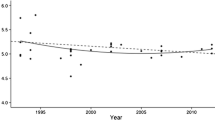Abstract
In 1973, Constantinople revolutionized the conceptualization of male and female sex roles when she advanced that masculinity and femininity were not opposite ends of a unidimensional continuum but rather independent constructs. This gave rise to androgyny theory, which advanced that individuals could be both masculine and feminine, and that in fact, the most healthy gender orientation was one containing elements of both. Nearly two decades after the development of the androgyny theory and the Bem Sex Role Inventory (BSRI), one of its most popular measures, it seems prudent to reexamine the androgyny construct and its measurement. This paper does just that. Within the context of a predominantly middle-class, Caucasian population, this study uses factor analysis, reliability estimates, and measures of population agreement to assess the continuing validity and reliability of the BSRI and androgyny theory. While reinforcing the reliability of the BSRI, results raise both methodological and conceptual questions regarding the BSRI and the operationalization of androgyny.
Similar content being viewed by others
References
Ballard-Reisch, D. (1989, Spring). Biological sex, gender orientation and communication competence in acquaintance dyads. Journal of the Northwest Communication Association, 17, 62–82.
Bem, S. (1974). The measurement of psychological androgyny. Journal of Consulting and Clinical Psychology, 42, 155–162.
Bem, S. (1975). Sex role adaptability: One consequence of psychological androgyny. Journal of Personality and Social Psychology, 31, 634–643.
Bem, S. (1977). On the utility of alternative procedures for assessing psychological androgyny. Journal of Consulting and Clinical Psychology, 45, 196–205.
Bem, S. (1979). Theory and measurement of androgyny: A reply to Pedhazur-Tetenbaum and Locksley-Colten critiques. Journal of Personality and Social Psychology, 37, 1047–1054.
Broverman, I., Vogel, S., Broverman, D., Clarkson, F., & Rosencrantz, P. (1972). Sex role stereotypes: A current appraisal. Journal of Social Issues, 28, 59–78.
Cronbach, L. (1951) Coefficient alpha and the internal structure of tests. Psychometrika, 16, 297–334.
Constantinople, A. (1973). Masculinity-femininity: An exception to a famous dictum. Psychological Bulletin, 80, 389–407.
Gorsuch, R. L. (1974). Factor analysis. Philadelphia: W. B. Saunders Company.
Kaplan, A., & Bean, J. (1976). From sex stereotypes to androgyny: Considerations of societal and individual change. In Beyond sex-role stereotypes: Readings toward a psychology of androgyny. Boston: Allyn & Bacon.
Helmreich, R., Spence, J., & Holahan, C. (1979). Psychological androgyny and sex role flexibility: A test of two hypotheses. Journal of Personality and Social Psychology, 37, 1631–1644.
Moreland, J. R., Gulanick, N., Montague, E. K., & Harren, V. A. (1978). Some psychometric properties of the Bem Sex Role Inventory. Applied Psychological Measurement, 2, 249–256.
Nunnally, J. (1978) Psychometric theory (2nd ed.). New York: McGraw-Hill.
Pedhazur, E., & Tetenbaum, T. (1979). Bem Sex Role Inventory: A theoretical and methodological critique. Journal of Personality and Social Psychology, 37, 996–1016.
Spence, J. T. & Helmreich, R. L. (1979). The many faces of androgyny: A reply to Locksley and Colten. Journal of Personality and Social Psychology, 37, 1032–1046.
Wheeless, L. R. & Wheeless, V. E. (1982). Attribution, gender orientation, and adaptability: Reconceptualization, measurement, and research results. Communication Quarterly, 30, 56–66.
Wheeless, V. E. & Dierks-Stewart (1981). The psychometric properties of the Bem Sex-role inventory: Questions concerning reliability, and validity. Communication Quarterly, 29, 173–186.
Whitley, B. E., Jr. (1984). Sex-role and psychological well-being: Two meta-analysis. Journal of Sex Roles, 12, 207–221.
Author information
Authors and Affiliations
Rights and permissions
About this article
Cite this article
Ballard-Reisch, D., Elton, M. Gender orientation and the Bem Sex Role Inventory: A psychological construct revisited. Sex Roles 27, 291–306 (1992). https://doi.org/10.1007/BF00289930
Issue Date:
DOI: https://doi.org/10.1007/BF00289930




